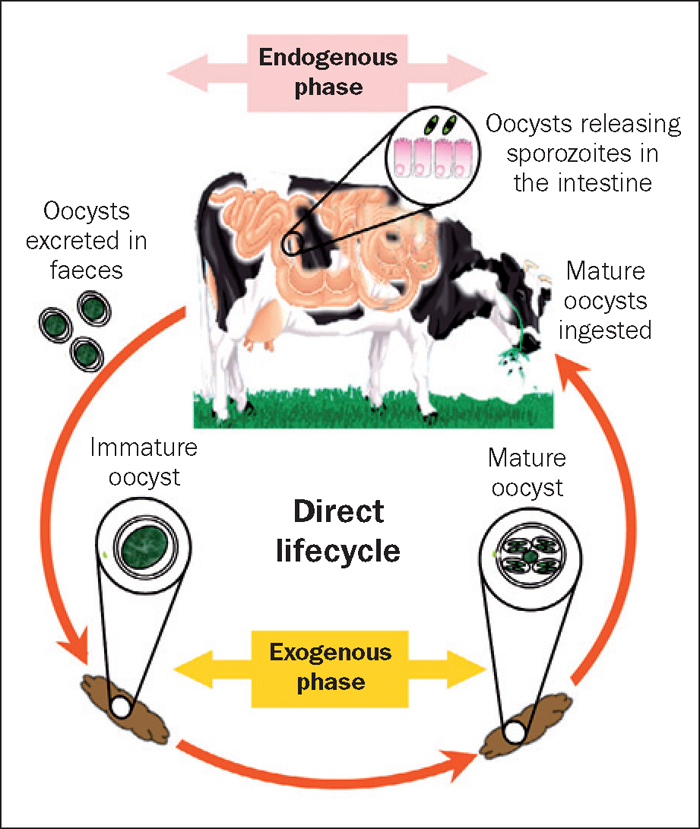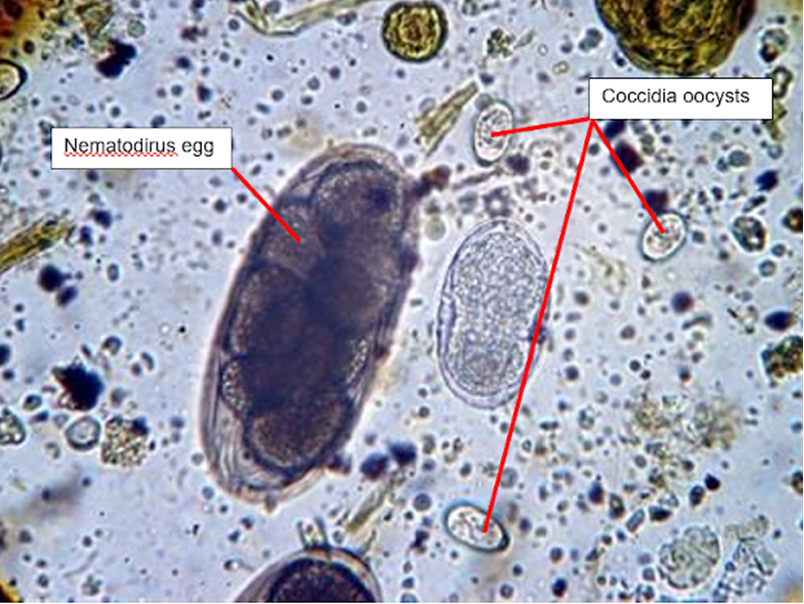Overview
Coccidiosis is a protozoal disease affecting the intestinal tract of cattle, primarily caused by Eimeria species such as E. bovis and E. zuernii. It predominantly affects young calves, leading to significant economic losses due to impaired growth and, in severe cases, mortality.

Etiology
- Pathogens: Eimeria bovis, Eimeria zuernii, and other Eimeria species.
- Transmission: Fecal-oral route via ingestion of sporulated oocysts from contaminated environments.
- Risk Factors: Overcrowding, poor sanitation, stress, and mixing of age groups.vettimes.co.uk
Clinical Signs
- Diarrhea, often containing mucus and blood.
- Tenesmus (straining) and possible rectal prolapse.
- Dehydration, weight loss, and poor growth rates.
- Lethargy and reduced feed intake.
- In severe cases, sudden death may occur.MSD Veterinary Manual
Diagnosis
- Clinical Evaluation: Observation of characteristic signs in affected age groups. This is how it will look like…

- Fecal Examination: Identification of oocysts using flotation techniques. Note that oocyst counts may not always correlate with disease severity.

- Postmortem Findings: Lesions in the intestinal mucosa, especially in the cecum and colon.
Treatment
- Anticoccidial Drugs:
- Amprolium: 10 mg/kg orally for 5 days.
- Sulfaquinoxaline: 13 mg/kg orally for 3–5 days.
- Toltrazuril: 15 mg/kg as a single oral dose.
- Diclazuril: 1 mg/kg as a single oral dose.
- Supportive Care: Fluid therapy to address dehydration; avoid corticosteroids as they may exacerbate oocyst shedding.Merck Veterinary Manual
Prevention
- Management Practices:
- Implement “all-in, all-out” systems with thorough cleaning between groups.
- Maintain dry and clean bedding; ensure proper ventilation.
- Avoid mixing calves of different ages.
- Raise feed and water troughs to minimize fecal contamination.
- Prophylactic Medications:
- Decoquinate: 0.5 mg/kg in feed daily for at least 28 days.
- Monensin: 0.3–0.9 mg/kg in feed daily.
- Lasalocid: 0.75–3 mg/kg in feed daily.Merck Veterinary Manual
NAVLE-Style Multiple-Choice Questions
Question 1:
A group of 4-week-old calves presents with diarrhea containing mucus and blood, straining, and weight loss. Fecal examination reveals Eimeria oocysts. What is the most appropriate initial treatment?
A. Administer corticosteroids to reduce inflammation
B. Provide toltrazuril at 15 mg/kg orally as a single dose
C. Isolate affected calves and withhold feed for 24 hours
D. Begin antibiotic therapy targeting gram-positive bacteria
E. Administer a single dose of ivermectin
Correct Answer: B. Provide toltrazuril at 15 mg/kg orally as a single dose
Explanation: Toltrazuril is effective against all intracellular stages of Eimeria and is administered as a single dose, making it suitable for treating coccidiosis in calves.Farm Portal
Question 2:
Which management practice is most effective in preventing coccidiosis outbreaks in calf-rearing facilities?
A. Mixing calves of different ages to promote immunity
B. Using the same pasture for consecutive calf groups
C. Implementing “all-in, all-out” systems with thorough sanitation
D. Feeding calves on the ground to encourage natural behaviors
E. Limiting ventilation to maintain higher temperatures
Correct Answer: C. Implementing “all-in, all-out” systems with thorough sanitation
Explanation: “All-in, all-out” management with proper cleaning and disinfection between groups reduces environmental contamination with oocysts, thereby lowering infection pressure.NADIS
Question 3:
A calf exhibits signs of coccidiosis. Which of the following is contraindicated in its treatment?
A. Providing supportive fluid therapy
B. Administering amprolium at 10 mg/kg orally for 5 days
C. Using corticosteroids to reduce intestinal inflammation
D. Ensuring clean and dry housing conditions
E. Isolating the affected calf from the group
Correct Answer: C. Using corticosteroids to reduce intestinal inflammation
Explanation: Corticosteroids are contraindicated as they can suppress the immune response and may increase oocyst shedding, worsening the infection.
References
- Merck Veterinary Manual. (2024). Coccidiosis in Cattle. Merck & Co., Inc.
- Radostits, O.M., Gay, C.C., Hinchcliff, K.W., Constable, P.D. (2007). Veterinary Medicine: A Textbook of the Diseases of Cattle, Horses, Sheep, Pigs and Goats. 10th ed. Saunders Elsevier.
- NADIS – National Animal Disease Information Service. Coccidiosis in Cattle
- Constable, P.D., Hinchcliff, K.W., Done, S.H., Grünberg, W. (2017). Veterinary Medicine: A Textbook of the Diseases of Cattle, Horses, Sheep, Pigs and Goats. 11th ed. Elsevier.
- Veterinary Practice News. (2023). Diagnosis and Management of Calf Diarrhea
- Vet Times. (2022). Coccidiosis: Incidence, Control and Epidemiology
- Cornell University College of Veterinary Medicine. Coccidiosis Fact Sheet